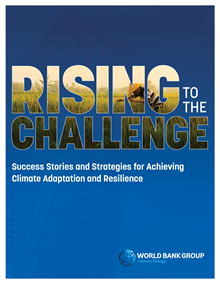- About 1.2 billion people are at high risk from climate-related hazards, but much can be done to make people, business, communities, and countries more resilient.
- A combination of more rapid development, more resilient development, and targeted adaptation interventions can reduce climate and disaster impacts.
- Development plays a key role as nobody can be resilient without access to basic infrastructure and social services, decent housing, or while living in poverty. While a 10-percent increase in income is associated with a decrease in the population at high risk by close to 100 million people, current development patterns will not be enough.
- An assessment of 44 countries shows that, in spite of growing attention and adaptation planning, most countries are still lagging in implementing resilience interventions, especially those related to policies and macro-fiscal dimensions, and in the monitoring and evaluation of their actions.
- However, the report dispels the idea that no progress is being done. With a collection of 30 examples from the private sector and 9 public-sector reforms or interventions, including public-private partnerships, it shows that promising adaptation and resilience efforts are undertaken globally and have measurable results. These initiatives and good practices can be replicated to scale up action and to build resilience for all.



